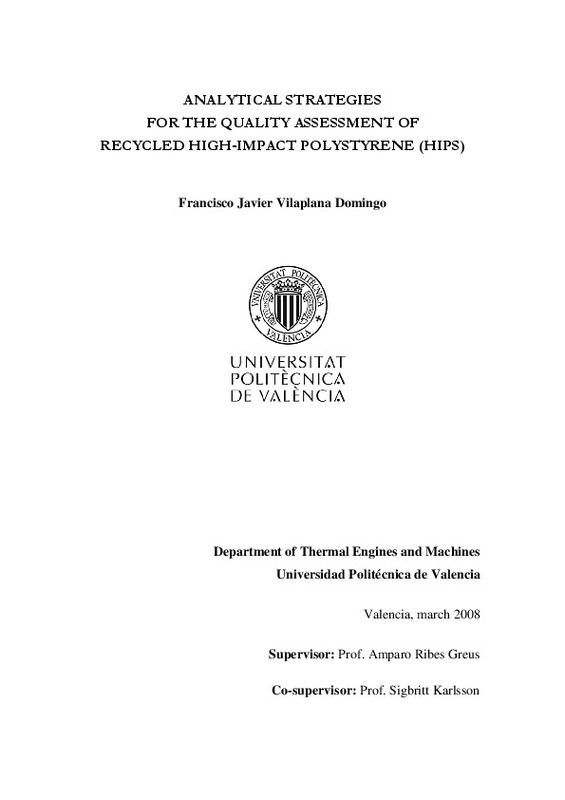- RiuNet repositorio UPV
- :
- Investigación
- :
- Tesis doctorales
- :
- Ver ítem
JavaScript is disabled for your browser. Some features of this site may not work without it.
Buscar en RiuNet
Listar
Mi cuenta
Estadísticas
Ayuda RiuNet
Admin. UPV
Analytical strategies for the quality assessment of recycled high-impact polystyrene (HIPS)
Mostrar el registro sencillo del ítem
Ficheros en el ítem
| dc.contributor.advisor | Ribes Greus, María Desamparados
|
es_ES |
| dc.contributor.advisor | Karlsson, Sigbritt
|
es_ES |
| dc.contributor.author | Vilaplana Domingo, Francisco Javier
|
es_ES |
| dc.date.accessioned | 2008-05-30T11:38:51Z | |
| dc.date.available | 2008-05-30T11:38:51Z | |
| dc.date.created | 2008-05-09T08:00:00Z | es_ES |
| dc.date.issued | 2008-05-30T11:38:37Z | es_ES |
| dc.identifier.uri | http://hdl.handle.net/10251/2186 | |
| dc.description.abstract | Polymers are subjected to physical and chemical changes during their processing, service life, and further recovery, and they may also interact with impurities that can alter their composition. These changes substantially modify the stabilisation mechanisms and mechanical properties of recycled polymers. The assessment of the quality properties of recycled polymers is therefore crucial to guarantee the performance of recyclates in further applications. Three key quality properties have been defined for this quality analysis: degree of mixing (composition), degree of degradation, and presence of low molecular weight compounds (degradation products, contaminants, additives). Furthermore, detailed knowledge about how the different stages of their life cycle affect the degree of degradation of polymeric materials is important when discussing their further waste recovery possibilities and the performance of recycled plastics. A dual-pronged experimental approach employing multiple processing and thermo-oxidation has been proposed to model the life cycle of recycled high-impact polystyrene (HIPS used in packaging applications, and electrical and electronic equipment (E&E). Both reprocessing and thermo-oxidative degradation are responsible for coexistent physical and chemical effects (chain scission, crosslinking, apparition of oxidative moieties, polymeric chain rearrangements, and physical ageing) on the microstructure and morphology of polybutadiene (PB) and polystyrene (PS) phases; these effects ultimately influence the long-term stability, and the rheological and mechanical behaviour of HIPS. The PB phase has proved to be the initiation point of HIPS degradation throughout the life cycle. Thermo-oxidation seems to have more severe effects on HIPS properties; therefore, it can be concluded that previous service life may be the part of the life cycle with the greatest influence on the recycling possibilities and performance of HIPS recyclates in second-market applicat | es_ES |
| dc.language | Español | es_ES |
| dc.publisher | Universitat Politècnica de València | es_ES |
| dc.rights | Reserva de todos los derechos | es_ES |
| dc.source | Riunet | |
| dc.subject | Waste electrical and electronic equipment | es_ES |
| dc.subject | Thermo-oxidation | es_ES |
| dc.subject | Recycling | es_ES |
| dc.subject | High-impact polystyrene | es_ES |
| dc.subject | Quality analysis | es_ES |
| dc.subject | Degradation | es_ES |
| dc.subject | Reprocessing | es_ES |
| dc.subject | Brominated flame retardants | es_ES |
| dc.subject.classification | MAQUINAS Y MOTORES TERMICOS | es_ES |
| dc.title | Analytical strategies for the quality assessment of recycled high-impact polystyrene (HIPS) | |
| dc.type | Tesis doctoral | es_ES |
| dc.subject.unesco | 230416 - Análisis de polímeros | es_ES |
| dc.subject.unesco | 331210 - Plásticos | es_ES |
| dc.identifier.doi | 10.4995/Thesis/10251/2186 | es_ES |
| dc.rights.accessRights | Abierto | es_ES |
| dc.contributor.affiliation | Universitat Politècnica de València. Departamento de Máquinas y Motores Térmicos - Departament de Màquines i Motors Tèrmics | es_ES |
| dc.description.bibliographicCitation | Vilaplana Domingo, FJ. (2008). Analytical strategies for the quality assessment of recycled high-impact polystyrene (HIPS) [Tesis doctoral]. Universitat Politècnica de València. https://doi.org/10.4995/Thesis/10251/2186 | es_ES |
| dc.description.accrualMethod | Palancia | es_ES |
| dc.type.version | info:eu-repo/semantics/acceptedVersion | es_ES |
| dc.relation.tesis | 2785 | es_ES |
Este ítem aparece en la(s) siguiente(s) colección(ones)
-
Tesis doctorales [5389]







![Text file [Text]](/themes/UPV/images/text.png)


